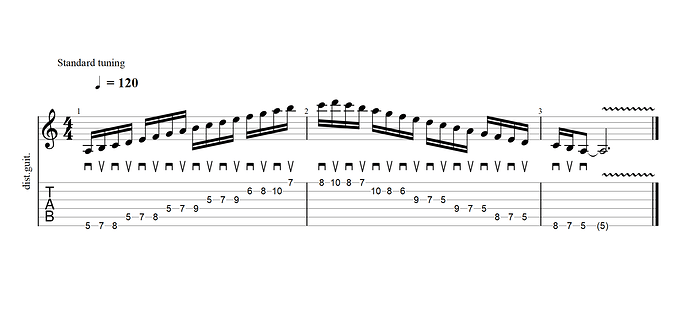I could have missed it, but are there any videos addressing running up and down say an A Aeolian 3 note per string mode from low E to high E and then back down where each 3 notes you would essentially switch between USX and DSX?
What exactly are you looking for? Based off of pick strokes, an ascending/descending 3nps scale would transition strings as follows:
D,U,D (DSX) U,D,U (USX), etc, etc.
Yes, you can check out the Antigravity seminar:
However, this is getting a little old at this point, and if it has a shortcoming, it’s that the tutorial aspect on how to actually do the motions doesn’t really take into account that players use different picking motions: wrist, forearm, elbow, and so on. So the very general concept of “make a motion that does this” is sound, but the actual joint motions needed to do it may vary based on what your current picking motion actually is.
For a more current look at what we know now, you can check out these two sections of the Primer, which are brand new:
They are not tutorials, but they provide our clearest overview yet as to different methods that players use to do something like playing a scale. In particular, you’ll notice in the “Primary Plus Secondary” overview that there are times where the “down up rotate” instructions provided in Antigravity simply aren’t used at all - there is no rotation, just a change in the direction the pick is moving. This happens primarily with wrist players like Andy Wood or Paul Gilbert.
Second, in the “Primary DBX” section, you’ll notice that players who we might think of as “double escape” don’t always specifically make a double escape motion, instead making subtle changes to their technique where the motion can look very similar to “primary secondary” crowd, i.e. different single escape motions trading off to handle different string changes.
We will be adding more tutorial stuff to the Primer to cover these topics, and when we do, we’ll be adding them specifically to the joint motion tutorials they match with, so scale playing with wrist motion will go in the wrist motion section, scale playing with wrist/forearm will go in that section, and so on.
Sorry for the complexities here - we’re always learning! But the goal is to simplify over time. For the time being I’d make sure you have a solid handle on which joint motion you’re currently using, because playing a scale with that motion is ultimately going to look very similar to whatever you’re currently doing, with only small and in some cases almost imperceptible motion changes unless you’re filming with a Magnet. In other words, if you can do a single escape motion, you’re already probably pretty close.
Thanks Troy I’ll be watching these videos now. And ya I went through all the motions in the primer and the only one that addressed it (sort of lol) was the forearm tracking vid. I look forward to the new vids and I do understand tracking is sort of mysterious and should come “naturally” but a deeper dive into these mechanics might just streamline some people’s road to success as your other videos have already done. I’m so grateful for all the amazing info in CtC, clearly you have made cracking this code a mission and it shows. You have a longtime member here  Keep it up!
Keep it up!

